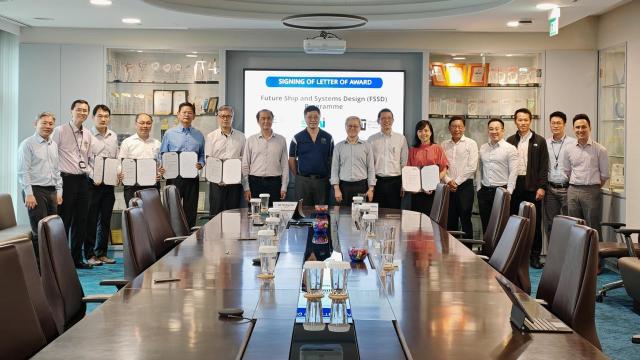More engineers are needed in Singapore, especially as the city-state gears up to be a smart nation. Find out how SIT students transit seamlessly into the workforce by learning through gamification of classroom activities.
“Who wants to be a millionaire?” a tutor proclaims, as a class of engineering students briskly organises itself into teams.
Such a sight is not uncommon at the Singapore Institute of Technology (SIT), where popular game shows such as “Who Wants to be a Millionaire?” and “Win, Lose or Draw” are adapted into stimulating classroom games. The topic in question – Non-Destructive Testing (NDT) – is a heavy one, comprising various testing and analysis techniques used in the transport, marine, petrochemical and aviation industries to identify defects in materials and structures.
“As the theories involved in NDT are broad, many concepts in the field need to be understood and, in most cases, can be better described through illustrations,” Associate Professor Edmund Liew explains. In fact, A/Prof Liew reveals that there are also questions in SIT’s written tests that require students to sketch NDT concepts.
“Since 2017, we have transformed the delivery of our NDT courses with a blended learning approach. Instead of conventional tutorials with written assignments, we have gamified our classes to include competitive crossword puzzles and game show-like activities to generate student interests.”
In “Who Wants to be a Millionaire?” for instance, teams compete in a series of multiple-choice questions. In “Win, Lose or Draw”, an American game show based on Pictionary, teams battle it out to correctly guess as many terminologies or concepts as possible with no hints other than their teammates’ sketches.
Such interactive learning methods have helped students such as Keric Phua, 25, quickly digest complex NDT knowledge.
“I recall Ultrasonic Testing as particularly difficult to understand, especially the part about how ultrasonic waves behave. The classroom games really helped because our learning is reinforced whenever our classmates share their understanding of the concepts. At the same time, we get to learn from mistakes, all in an entertaining and thrilling way,” the Year 3 Sustainable Infrastructure Engineering (Land) student describes.
“I love how everyone had their own style of drawing schematic diagrams in the ‘Win, Lose or Draw’ game,” he recalls. “Some classmates were very artistic, while others were less so. The diagrams would come out pretty funny when the not-so-artistic students – myself included – drew the diagrams.”
“There was once when one of our classmates started drawing trees. His teammates’ guesses were so far off the charts that they bent over laughing when the tutor revealed the answer: ‘weld root’!”.

Students having practical training on ultrasonic testing.
‘Flipped Classroom’ Learning
In his course of study, Keric also benefited from SIT’s how-to videos, which describe working principles and depict guided demonstrations of several NDT methods commonly practiced in the industry.
“Instead of reading through notes to figure out how to operate the equipment, we can now model after the demonstrations in the videos, which helps us to learn a lot faster,” says Keric. “We can also view, pause and replay the videos at our own learning pace and convenience.”
This is known as ’flipped classroom‘, in which instructional content is delivered to students outside of the classroom. “The flipped classroom approach allows us to introduce students to new concepts before laboratory sessions, so that the time can instead be more effectively used to deepen understanding through discussions with peers and problem-solving activities while undertaking practical experiments with the NDT methods,” A/Prof Liew shares.
“What we have done is to prioritise active participation in class through student-centred applied learning methods,” A/Prof Liew says. “This reinforces learning and understanding in the NDT courses.”

Student-centred applied learning methods helps to reinforce learning and understanding.
Paving the Way
To practice NDT in the industry, engineers must be NDT-certified. Upon completion of SIT’s NDT classroom and practical laboratory sessions, students will embark on the Integrated Work Study Programme (IWSP), which involves full-time work in a relevant industry for up to a year as part of their degree. Students who have completed their IWSP with the required duration of industrial experience in the field of NDT will receive a Certificate of Attainment, which qualifies them to undertake the examinations for Level 2 professional certification of the NDT methods practiced.
“Since practical training is required, NDT certification is typically only achieved by working professionals, managers and technicians in the industry,” A/Prof Liew elaborates. “With the IWSP however, students can gain application experience by working full-time in their third year of study.” If a student practices NDT during his or her IWSP, this essentially fulfils the industrial experience component required for the NDT certification.
“By taking on an applied learning approach, we have opened more doors for our engineering graduates to be work-ready when they achieve the NDT certification before entering the workforce.”
The case study on 'Coupling University Education with an Industrial Professional Certification' was featured in the book 'Applied Learning in Higher Education: Perspectives, Pedagogy, and Practice'. The book is available for purchase online from Informing Science Press, Amazon, and Google Play.
![[FA] SIT One SITizen Alumni Initiative_Web banner_1244px x 688px.jpg](/sites/default/files/2024-12/%5BFA%5D%20%20SIT%20One%20SITizen%20Alumni%20Initiative_Web%20banner_1244px%20x%20688px.jpg)


